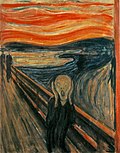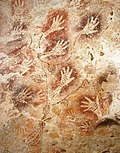Portal:Visual arts
Introduction

The visual arts are art forms such as painting, drawing, printmaking, sculpture, ceramics, photography, video, image, filmmaking, design, crafts, and architecture. Many artistic disciplines such as performing arts, conceptual art, and textile arts, also involve aspects of the visual arts, as well as arts of other types. Within the visual arts, the applied arts, such as industrial design, graphic design, fashion design, interior design, and decorative art are also included.
Current usage of the term "visual arts" includes fine art as well as applied or decorative arts and crafts, but this was not always the case. Before the Arts and Crafts Movement in Britain and elsewhere at the turn of the 20th century, the term 'artist' had for some centuries often been restricted to a person working in the fine arts (such as painting, sculpture, or printmaking) and not the decorative arts, crafts, or applied visual arts media. The distinction was emphasized by artists of the Arts and Crafts Movement, who valued vernacular art forms as much as high forms. Art schools made a distinction between the fine arts and the crafts, maintaining that a craftsperson could not be considered a practitioner of the arts.
The increasing tendency to privilege painting, and to a lesser degree sculpture, above other arts has been a feature of Western art as well as East Asian art. In both regions, painting has been seen as relying to the highest degree on the imagination of the artist and being the furthest removed from manual labour – in Chinese painting, the most highly valued styles were those of "scholar-painting", at least in theory practiced by gentleman amateurs. The Western hierarchy of genres reflected similar attitudes. (Full article...)
Selected article

B of the Bang was a sculpture by Thomas Heatherwick next to the City of Manchester Stadium in Manchester, England, United Kingdom, which was commissioned to mark the 2002 Commonwealth Games; at 56 metres (184 ft) it was one of the tallest structures in Manchester and the tallest sculpture in the UK until the completion of Aspire in 2008. The sculpture took its name from a quotation of British sprinter Linford Christie, in which he said that he started his races not merely at the "bang" of the starting pistol, but at "the B of the Bang".
The sculpture was commissioned in 2003; construction overran and the official unveiling was delayed until 12 January 2005. Six days before the launch, the sculpture suffered the first of three visible structural problems as the tip of one of the spikes detached and fell to the ground. Legal action to repair the sculpture was started by Manchester City Council a year later, resulting in an out-of-court settlement totalling £1.7 million. (Full article...)
Selected picture

Selected quote
| “ | When I've painted a woman's behind so that I want to touch it, then it's finished! | ” |
| — Pierre-Auguste Renoir,Vollard, Ambroise (1925). Renoir: an initimate record. Translated by Van Dooren, Harold L.; Weaver, Randolph T. New York: Alfred A. Knopf. p. 57. OCLC 631984646. |
Related portals
Selected biography
John Thirtle (baptised 22 June 1777 – 30 September 1839) was an English watercolour artist and frame-maker. Born in Norwich, where he lived for most of his life, he was a leading member of the Norwich School of painters.
Much of Thirtle's life is undocumented. After working as an apprentice to a London frame-maker, he returned to Norwich to establish his own frame-making business. During his career he also worked as a drawing-master, a printseller and a looking glass maker. He produced frames for paintings by several members of the Norwich School, including John Crome and John Sell Cotman. Throughout his working life he continued to paint. In 1812 he married Elizabeth Miles, the sister of Cotman's wife Ann. Thirtle suffered from tuberculosis during the last two decades of his life, and his worsening health reduced his artistic output up to his death in 1839. His Manuscript Treatise on Watercolour, unpublished before 1977, was probably for his own use, and he exhibited fewer than 100 paintings. A member of the Norwich Society of Artists, he briefly served as its vice-president, but in 1816 was one of the artists who seceded from the Society to form a separate association, the Norfolk and Norwich Society of Artists, which dissolved after three years. (Full article...)
Did you know (auto generated) -

- ... that The Wiccan Web recommends drawing pentagrams on your computer screen with tinctures?
- ... that in May 1983 British public health physician Spence Galbraith suggested withdrawing blood products made from blood donated in the U.S. after 1978?
- ... that art historian Zehava Jacoby was able to suggest a reconstruction of the lost tomb of Baldwin V of Jerusalem, destroyed in an 1808 fire, using an 18th-century drawing by Elzear Horn?
- ... that Bernie Wrightson spent seven years drawing an illustrated edition of Mary Shelley's 1818 novel Frankenstein?
- ... that the art of Irma Blank, of "drawing languages without words" and including sounds, was recognised in the 1970s but fell into obscurity until a rediscovery in the 2010s?
- ... that to encourage the development of Bissau-Guinean cinema, one foreign filmmaker provided the country's film institute with cameras, lights, and a Steinbeck guitar?
- ... that Sarah Pickstone based her John Moores Prize–winning painting on an illustration that accompanied the poem "Not Waving but Drowning"?
- ... that the documentary Railway with a Heart of Gold has actual footage of a derailment captured whilst the filmmaker was attached to the side of the train?
General images
Major topics
- Types of visual art – Architecture • Art intervention • Ceramic art • Computer art • Drawing • Fashion • Film • Installation art • Land art • Mixed media • Painting • Performance art • Photography • Printmaking • Sculpture • Stained glass; • Artists' Books
- Art history – Pre-historic art • Ancient art • Art of Ancient Egypt • Art in Ancient Greece • Minoan pottery • Scythian art • Roman art • Women artists
- Western art periods and movements – Medieval art • Gothic art • Renaissance • Mannerism • Baroque • Rococo • Neoclassicism • Romanticism • Realism • Modern Art • Impressionism • Symbolism • Fauvism • Proto-Cubism • Cubism • Futurism • Dada • Art Deco • Surrealism • Abstract Expressionism • Lyrical abstraction • Conceptual Art • Contemporary Art • Postmodern art visual arts.
- Eastern and Middle Eastern art – Buddhist art • Chinese art • Islamic art • Japanese art • Laotian art • Thai art • Tibetan art
- Lists – Architects • Art movements • Art periods • Painters • Printmakers • Sculptors • Statues
- Lists of basic topics – Visual arts • Architecture • Film • Painting • Photography • Sculpture
Subcategories

Architecture | Ceramic art | Comics | Crafts | Design | Drawing | Illustration | Film | Glass | Graphic design | Industrial design | Landscape architecture | Multimedia | Painting | Photography | Pottery | Printmaking | Public art | Sculpture | Typography | Mosaic
Artists | Visual arts awards | Artist collectives | Art collectors | Art critics | Art curators | Visual arts exhibitions | Art forgery | Art history | Visual arts materials | Art schools | Artistic techniques |
WikiProjects
Things you can do
Associated Wikimedia
The following Wikimedia Foundation sister projects provide more on this subject:
- Commons
Free media repository - Wikibooks
Free textbooks and manuals - Wikidata
Free knowledge base - Wikinews
Free-content news - Wikiquote
Collection of quotations - Wikisource
Free-content library - Wikiversity
Free learning tools - Wiktionary
Dictionary and thesaurus













































































